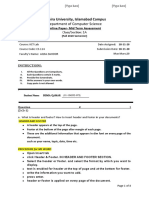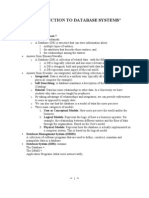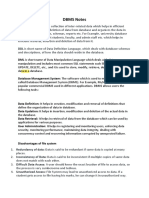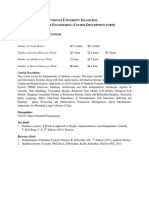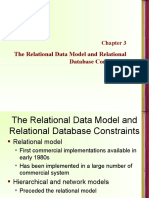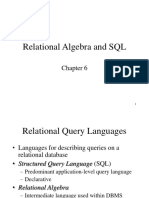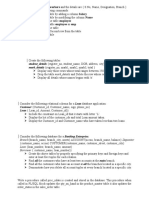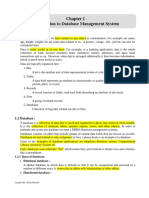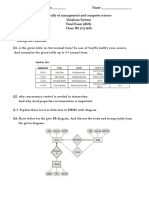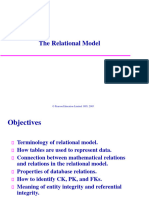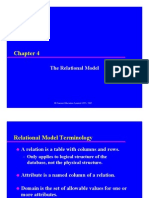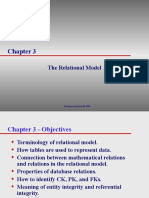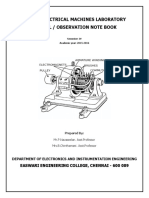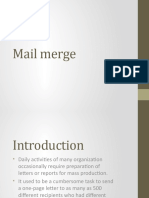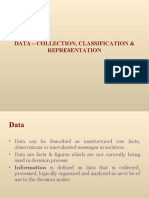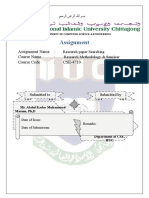Chapter 3
The Relational Model
Transparencies
© Pearson Education Limited 1995, 2005
Chapter 3 - Objectives
◆ Terminology of relational model.
◆ How tables are used to represent data.
◆ Connection between mathematical relations
and relations in the relational model.
◆ Properties of database relations.
◆ How to identify CK, PK, and FKs.
◆ Meaning of entity integrity and referential
integrity.
◆ Purpose and advantages of views.
2
© Pearson Education Limited 1995, 2005
Relational Model Terminology
◆ A relation is a table with columns and rows.
– Only applies to logical structure of the
database, not the physical structure.
◆ Attribute is a named column of a relation.
◆ Domain is the set of allowable values for one or
more attributes.
3
© Pearson Education Limited 1995, 2005
Relational Model Terminology
◆ Tuple is a row of a relation.
◆ Degree is the number of attributes in a relation.
◆ Cardinality is the number of tuples in a relation.
◆ Relational Database is a collection of normalized
relations with distinct relation names.
4
© Pearson Education Limited 1995, 2005
Instances of Branch and Staff Relations
© Pearson Education Limited 1995, 2005
Examples of Attribute Domains
6
© Pearson Education Limited 1995, 2005
Alternative Terminology for Relational Model
7
© Pearson Education Limited 1995, 2005
Mathematical Definition of Relation
◆ Consider two sets, D1 & D2, where D1 = {2, 4} and D2
= {1, 3, 5}.
◆ Cartesian product, D1 × D2, is set of all ordered pairs,
where first element is member of D1 and second
element is member of D2.
D1 × D2 = {(2, 1), (2, 3), (2, 5), (4, 1), (4, 3), (4, 5)}
◆ Alternative way is to find all combinations of elements
with first from D1 and second from D2.
8
© Pearson Education Limited 1995, 2005
Mathematical Definition of Relation
◆ Any subset of Cartesian product is a relation; e.g.
R = {(2, 1), (4, 1)}
◆ May specify which pairs are in relation using
some condition for selection; e.g.
– second element is 1:
R = {(x, y) | x ∈ D1, y ∈ D2, and y = 1}
– first element is always twice the second:
S = {(x, y) | x ∈ D1, y ∈ D2, and x = 2y}
9
© Pearson Education Limited 1995, 2005
Mathematical Definition of Relation
◆ Consider three sets D1, D2, D3 with Cartesian
Product D1 × D2 × D3; e.g.
D1 = {1, 3} D2 = {2, 4} D3 = {5, 6}
D1 × D2 × D3 = {(1,2,5), (1,2,6), (1,4,5), (1,4,6),
(3,2,5), (3,2,6), (3,4,5), (3,4,6)}
◆ Any subset of these ordered triples is a relation.
10
© Pearson Education Limited 1995, 2005
Mathematical Definition of Relation
◆ Cartesian product of n sets (D1, D2, . . ., Dn) is:
D1 × D2 × . . . × Dn = {(d1, d2, . . . , dn) | d1 ∈ D1, d2
∈ D2, . . . , dn∈ Dn}
usually written as:
n
X Di
i=1
◆ Any set of n-tuples from this Cartesian product is
a relation on the n sets.
11
© Pearson Education Limited 1995, 2005
Database Relations
◆ Relation schema
– Named relation defined by a set of attribute
and domain name pairs.
◆ Relational database schema
– Set of relation schemas, each with a distinct
name.
12
© Pearson Education Limited 1995, 2005
Properties of Relations
◆ Relation name is distinct from all other relation
names in relational schema.
◆ Each cell of relation contains exactly one atomic
(single) value.
◆ Each attribute has a distinct name.
◆ Values of an attribute are all from the same
domain.
13
© Pearson Education Limited 1995, 2005
Properties of Relations
◆ Each tuple is distinct; there are no duplicate
tuples.
◆ Order of attributes has no significance.
◆ Order of tuples has no significance, theoretically.
14
© Pearson Education Limited 1995, 2005
Relational Keys
◆ Superkey
– An attribute, or set of attributes, that uniquely
identifies a tuple within a relation.
◆ Candidate Key
– Superkey (K) such that no proper subset is a superkey
within the relation.
– In each tuple of R, values of K uniquely identify that
tuple (uniqueness).
– No proper subset of K has the uniqueness property
(irreducibility).
15
© Pearson Education Limited 1995, 2005
Relational Keys
◆ Primary Key
– Candidate key selected to identify tuples uniquely
within relation.
◆ Alternate Keys
– Candidate keys that are not selected to be primary
key.
◆ Foreign Key
– Attribute, or set of attributes, within one relation
that matches candidate key of some (possibly same)
relation.
16
© Pearson Education Limited 1995, 2005
Integrity Constraints
◆ Null
– Represents value for an attribute that is
currently unknown or not applicable for tuple.
– Deals with incomplete or exceptional data.
– Represents the absence of a value and is not the
same as zero or spaces, which are values.
17
© Pearson Education Limited 1995, 2005
Integrity Constraints
◆ Entity Integrity
– In a base relation, no attribute of a primary
key can be null.
◆ Referential Integrity
– If foreign key exists in a relation, either
foreign key value must match a candidate
key value of some tuple in its home relation
or foreign key value must be wholly null.
18
© Pearson Education Limited 1995, 2005
Integrity Constraints
◆ General Constraints
– Additional rules specified by users or
database administrators that define or
constrain some aspect of the enterprise.
19
© Pearson Education Limited 1995, 2005
Views
◆ Base Relation
– Named relation corresponding to an entity
in conceptual schema, whose tuples are
physically stored in database.
◆ View
– Dynamic result of one or more relational
operations operating on base relations to
produce another relation.
20
© Pearson Education Limited 1995, 2005
Views
◆ A virtual relation that does not necessarily actually
exist in the database but is produced upon request,
at time of request.
◆ Contents of a view are defined as a query on one or
more base relations.
◆ Views are dynamic, meaning that changes made to
base relations that affect view attributes are
immediately reflected in the view.
21
© Pearson Education Limited 1995, 2005
Purpose of Views
◆ Provides powerful and flexible security
mechanism by hiding parts of database from
certain users.
◆ Permits users to access data in a customized way,
so that same data can be seen by different users
in different ways, at same time.
◆ Can simplify complex operations on base
relations.
22
© Pearson Education Limited 1995, 2005
Updating Views
◆ All updates to a base relation should be
immediately reflected in all views that
reference that base relation.
◆ If view is updated, underlying base relation
should reflect change.
23
© Pearson Education Limited 1995, 2005
Updating Views
◆ There are restrictions on types of modifications that
can be made through views:
– Updates are allowed if query involves a single base
relation and contains a candidate key of base
relation.
– Updates are not allowed involving multiple base
relations.
– Updates are not allowed involving aggregation or
grouping operations.
24
© Pearson Education Limited 1995, 2005
Updating Views
◆ Classes of views are defined as:
– theoretically not updateable;
– theoretically updateable;
– partially updateable.
25
© Pearson Education Limited 1995, 2005




